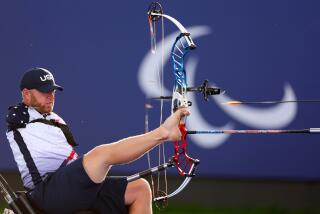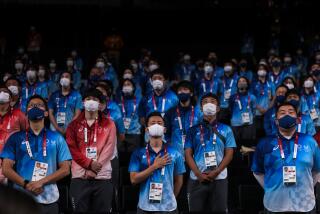Panathinaiko Has History Behind It, if Not Crowds
- Share via
ATHENS — Athletes compete beneath the stony gaze of a pair of statues of Zeus.
The stadium rests on a site where ancient Greeks used to run and throw and jump thousands of years ago.
Spectators sit on slabs of hard, unpolished marble hewn from the quarries of Mount Pendeli, watching competitors emerge from a catacomb-like tunnel that made one athlete say she felt like “a gladiator in the movie ‘Troy.’ ”
While Olympia basked in the international media’s strobe lights as new-world shotputters grunted on fabled grounds of antiquity, Panathinaiko Stadium offered its own considerable resume to anyone interested Wednesday.
That didn’t amount to many. Maybe a couple of thousand, at most. But then this was an archery competition, not the shotput, which is a popular, brute-strength exhibition that evokes images of Hercules and many of the A-list heroes of Greek mythology.
Archery, a subtler pastime, evokes the likes of Robin Hood and William Tell and Rudyard Kipling’s memorable observation that “Nothing is so tedious as an archery competition. They shot, and they shot, and they kept on shooting.... “
It can be a tough sport to sell, even when the shooting’s being done inside the stadium that launched the Modern Olympic Games in 1896, on a site where Greeks held athletic competitions as far back as 329 BC.
“We were hoping for a little bigger crowd,” Jim Easton, president of the International Archery Federation, acknowledged. “I wish we’d have had more.
“It’s such a great venue. It’s a historic place to be. We thought sure that the people would come here. It’s not an expensive ticket. You come here just to experience the stadium. That’s kind of what we thought would happen. We needed the Greek citizens to come here and enjoy.
“Unfortunately, their archer [Evangelia Psarra] who made it into the quarterfinals here didn’t win.”
Inside a white marble stadium that can seat 34,500, small clusters of fans rattled around while South Korea continued its recent domination of the women’s individual competition. Park Sung-Hyun defeated Lee Sung-Jin, 110-108, in an all-Korean gold-medal match, with Britain’s Alison Williamson edging Taiwan’s Yuan Shu Chi, 105-104, for the bronze.
From above the stadium’s upper rim, spectators could glimpse the Parthenon atop the Acropolis and imagine themselves having time-traveled back thousands of years.
Except for the giant, full-color video boards on the north end of the infield, complete with a “bull’s-eye cam” that Park disabled at least once with a perfect strike into the dead-center of the target.
And the stereo sound system blaring out the strains of the hymn “Believe” by the ancient goddess Cher.
And the red wind socks positioned atop each target, so stationed to monitor changes in the direction of the breeze.
Thousands of years ago, archers didn’t carry 38-pound recurve bows constructed of fiberglass and aluminum and fully loaded with stabilizer, sight window, handle rises and arrow rest. Their shots weren’t tallied on an electronic scoreboard, accompanied by P.A.-announcer yelps of “Deka!” whenever an archer collected the maximum 10 points by hitting the center of the target.
It’s a curious juxtaposition, the thoroughly modern clashing with the extremely old. Easton is pleased to see it. It took a long, hard struggle to get his sport here.
“We’ve got one of the oldest competitive sports in the world,” Easton said. “It sort of fit in this stadium -- an ancient sport into an ancient stadium.”
But Easton’s initial proposal to use the historic facility was rebuffed by the Athens 2004 organizers.
“They said, no, it’s a cultural landmark, we’re not going to have it desecrated by archery,” Easton said. “But we just persisted.”
With the help of Gianna Angelopoulos-Daskalaki, who was named president of the Athens organizing committee in 2000, a deal finally was arranged.
“She saw the wisdom of it, and she sort of gave it the final stamp of approval,” Easton said. “And then we went to work.
“Some of my colleagues in the [other] federations were wishing they had something like this. They said we got the best venue in Athens.”
If not the best-attended venue in Athens.
“We didn’t get a lot of [pre-Games] publicity,” Easton said. “I think the organizing committee was concentrating on getting everything done and to get the thing well-organized. I think some of the sports could have used more promotion in the area here to get people interested.
“But they sold their allotment of tickets. They brought in the dollars they wanted. So they’ve done their job collecting the money they wanted. But I think this would be a great place for the people to come. It’s only 10 Euros to come in and see something they haven’t seen before.”
Bronze medalist Williamson certainly enjoyed the ride.
“Every time I walk down the tunnel, I think, ‘This is amazing,’ ” she said. “I’d like to come and see it some day when I’m not competing.”
More to Read
Go beyond the scoreboard
Get the latest on L.A.'s teams in the daily Sports Report newsletter.
You may occasionally receive promotional content from the Los Angeles Times.






